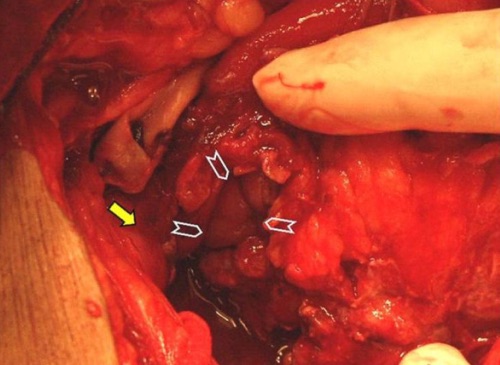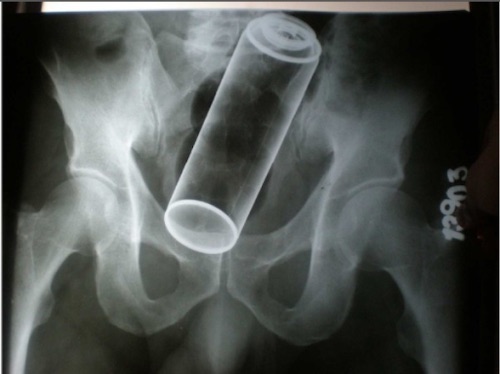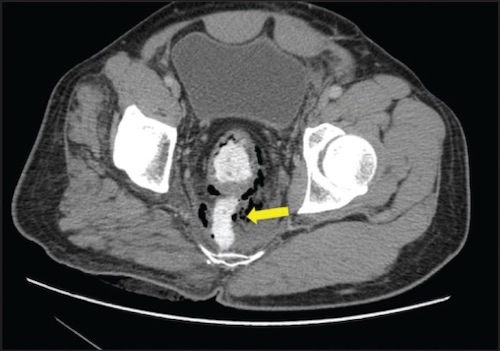Rectal Trauma
Rectal Trauma
David Ray Velez, MD
Table of Contents
Background
Anatomy
- About 15 cm in Length
- Proximal 2/3 is Intraperitoneal – Has Serosal Covering
- Distal 1/3 is Extraperitoneal – Difficult to Expose
Etiology
- The Majority (80%) are Caused by Gun Shot Wound (GSW)
- Blunt Trauma: 10%
- Transanal/Impalement Injury: 6%

Rectal Perforation 1

Rectal Foreign Body 2
Presentation and Diagnosis
Presentation
- Mostly Nonspecific
- Abdominal Pain
- Nausea and Vomiting
- Hematochezia or Blood per Rectum – Always Perform a Digital Rectal Exam (DRE) if Concerned
May Be Diagnosed Intraoperatively or on CT – Consider CT with IV and Rectal Contrast if Concerned
All Suspected Injuries Should Undergo Rigid Proctoscopy – May Miss Extraperitoneal Injuries without Endoscopy
AAST Rectum Injury Scale
- *See AAST
- Injury Scale is Under Copyright

Rectal Perforation with Contrast Extravasation 3
Intraperitoneal Injury – Treatment
Intraperitoneal Rectal Injuries are Often Treated Similar to Small Bowel and Colon Injuries
Definition of “Destructive” Bowel Injury
- Laceration > 50% Circumference or Transection
- Devascularized or “Bucket Handle” Injury
Non-Destructive Injury (Grade I-II): Primary Repair
- Close Transversely to Avoid Stricture if Able
- Close in One or Two-Layers – No Difference in Complication Rates
- May Convert Two Perforations Closely Opposed into a Single Defect
Destructive Injury (Grade III-V): Primary Repair vs. Low Anterior Resection (LAR)
- Anastomosis Can Be Handsewn or Stapled
- May Consider Primary Repair for Even Destructive Rectal Injuries if Feasible and Not Requiring Significant Blood Transfusion or Hemodynamically Unstable
Diversion (Ostomy) Indications
- Significant Blood Transfusion (> 4-6 Units)
- Shock on Vasopressor Support
- *Fecal Contamination Alone is Associated with Increased Risk of Abscess but Not Anastomotic Failure and Should Not Be Used as an Indication for Colostomy (Nor is Location or Associated Abdominal Injuries)
Extraperitoneal Injury – Treatment
Accessible: Primary Repair Through a Transanal Approach
- Transanal Minimally Invasive Surgery (TAMIS) if Able
- Diverting Colostomy if Requiring Significant Blood Transfusion or Hemodynamically Unstable
Inaccessible: Diverting Colostomy
- Loop Sigmoid Colostomy is Generally Preferred
- End Colostomy Considered for Devastating Injuries
- Can Take Down in 6-8 Weeks
Historical Considerations
- Presacral Drainage (Previously Recommended for Extraperitoneal Injuries) is Inadequate and Should Not Be Pursued
- Distal Rectal Washout is Outdated and May Actually Increase the Risk of Infectious Complications
References
- Hefny AF, Al-Ashaal YI, Bani-Hashem AM, Abu-Zidan FM. Seatbelt syndrome associated with an isolated rectal injury: case report. World J Emerg Surg. 2010 Feb 4;5(1):4. (License: CC BY-2.0)
- Coskun A, Erkan N, Yakan S, Yıldirim M, Cengiz F. Management of rectal foreign bodies. World J Emerg Surg. 2013 Mar 13;8(1):11. (License: CC BY-2.0)
- Hefny AF, Salim EA, Bashir MO, Abu-Zidan FM. An unusual stab wound to the buttock. J Emerg Trauma Shock. 2013 Oct;6(4):298-300. (License: CC BY-NC-SA-3.0)
